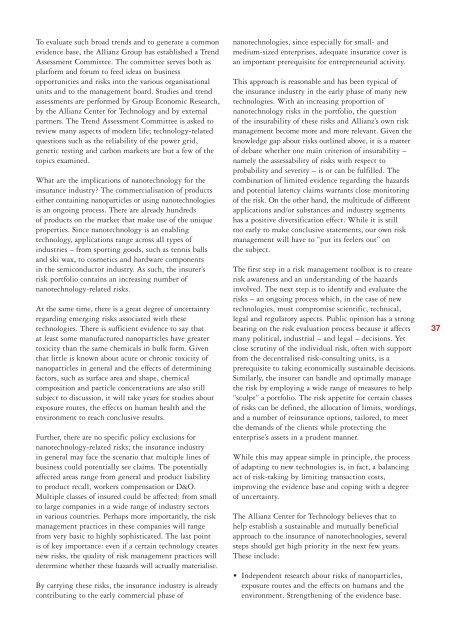Small size - large impact - Nanowerk
Small size - large impact - Nanowerk
Small size - large impact - Nanowerk
Create successful ePaper yourself
Turn your PDF publications into a flip-book with our unique Google optimized e-Paper software.
To evaluate such broad trends and to generate a common<br />
evidence base, the Allianz Group has established a Trend<br />
Assessment Committee. The committee serves both as<br />
platform and forum to feed ideas on business<br />
opportunities and risks into the various organisational<br />
units and to the management board. Studies and trend<br />
assessments are performed by Group Economic Research,<br />
by the Allianz Center for Technology and by external<br />
partners. The Trend Assessment Committee is asked to<br />
review many aspects of modern life; technology-related<br />
questions such as the reliability of the power grid,<br />
genetic testing and carbon markets are but a few of the<br />
topics examined.<br />
What are the implications of nanotechnology for the<br />
insurance industry? The commercialisation of products<br />
either containing nanoparticles or using nanotechnologies<br />
is an ongoing process. There are already hundreds<br />
of products on the market that make use of the unique<br />
properties. Since nanotechnology is an enabling<br />
technology, applications range across all types of<br />
industries – from sporting goods, such as tennis balls<br />
and ski wax, to cosmetics and hardware components<br />
in the semiconductor industry. As such, the insurer’s<br />
risk portfolio contains an increasing number of<br />
nanotechnology-related risks.<br />
At the same time, there is a great degree of uncertainty<br />
regarding emerging risks associated with these<br />
technologies. There is sufficient evidence to say that<br />
at least some manufactured nanoparticles have greater<br />
toxicity than the same chemicals in bulk form. Given<br />
that little is known about acute or chronic toxicity of<br />
nanoparticles in general and the effects of determining<br />
factors, such as surface area and shape, chemical<br />
composition and particle concentrations are also still<br />
subject to discussion, it will take years for studies about<br />
exposure routes, the effects on human health and the<br />
environment to reach conclusive results.<br />
Further, there are no specific policy exclusions for<br />
nanotechnology-related risks; the insurance industry<br />
in general may face the scenario that multiple lines of<br />
business could potentially see claims. The potentially<br />
affected areas range from general and product liability<br />
to product recall, workers compensation or D&O.<br />
Multiple classes of insured could be affected: from small<br />
to <strong>large</strong> companies in a wide range of industry sectors<br />
in various countries. Perhaps more importantly, the risk<br />
management practices in these companies will range<br />
from very basic to highly sophisticated. The last point<br />
is of key importance: even if a certain technology creates<br />
new risks, the quality of risk management practices will<br />
determine whether these hazards will actually materialise.<br />
By carrying these risks, the insurance industry is already<br />
contributing to the early commercial phase of<br />
nanotechnologies, since especially for small- and<br />
medium-<strong>size</strong>d enterprises, adequate insurance cover is<br />
an important prerequisite for entrepreneurial activity.<br />
This approach is reasonable and has been typical of<br />
the insurance industry in the early phase of many new<br />
technologies. With an increasing proportion of<br />
nanotechnology risks in the portfolio, the question<br />
of the insurability of these risks and Allianz’s own risk<br />
management become more and more relevant. Given the<br />
knowledge gap about risks outlined above, it is a matter<br />
of debate whether one main criterion of insurability –<br />
namely the assessability of risks with respect to<br />
probability and severity – is or can be fulfilled. The<br />
combination of limited evidence regarding the hazards<br />
and potential latency claims warrants close monitoring<br />
of the risk. On the other hand, the multitude of different<br />
applications and/or substances and industry segments<br />
has a positive diversification effect. While it is still<br />
too early to make conclusive statements, our own risk<br />
management will have to “put its feelers out” on<br />
the subject.<br />
The first step in a risk management toolbox is to create<br />
risk awareness and an understanding of the hazards<br />
involved. The next step is to identify and evaluate the<br />
risks – an ongoing process which, in the case of new<br />
technologies, must compromise scientific, technical,<br />
legal and regulatory aspects. Public opinion has a strong<br />
bearing on the risk evaluation process because it affects<br />
many political, industrial – and legal – decisions. Yet<br />
close scrutiny of the individual risk, often with support<br />
from the decentralised risk-consulting units, is a<br />
prerequisite to taking economically sustainable decisions.<br />
Similarly, the insurer can handle and optimally manage<br />
the risk by employing a wide range of measures to help<br />
“sculpt” a portfolio. The risk appetite for certain classes<br />
of risks can be defined, the allocation of limits, wordings,<br />
and a number of reinsurance options, tailored, to meet<br />
the demands of the clients while protecting the<br />
enterprise’s assets in a prudent manner.<br />
While this may appear simple in principle, the process<br />
of adapting to new technologies is, in fact, a balancing<br />
act of risk-taking by limiting transaction costs,<br />
improving the evidence base and coping with a degree<br />
of uncertainty.<br />
The Allianz Center for Technology believes that to<br />
help establish a sustainable and mutually beneficial<br />
approach to the insurance of nanotechnologies, several<br />
steps should get high priority in the next few years.<br />
These include:<br />
• Independent research about risks of nanoparticles,<br />
exposure routes and the effects on humans and the<br />
environment. Strengthening of the evidence base.<br />
37
















